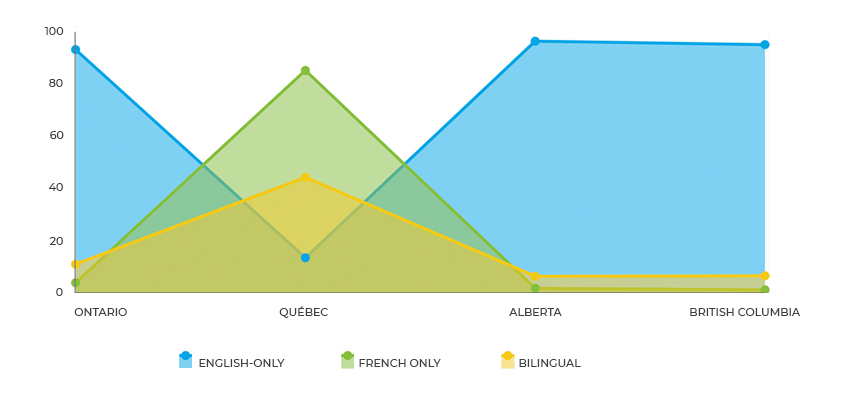Many US companies make the mistake of marketing to Canadians the same way they would to US consumers. After all, Canadians are our neighbors to the north. They speak English. It seems easy enough to include them as a target market with minimal effort – recycling a US domestic campaign should do the trick. However, failing to prioritize French-Canadian translation will ensure you miss the mark.
There are two key considerations when entering the Canadian market. First, French is an official language. By law, you can’t do business in Canada unless you market in both English and French. The other consideration is the culture. Canadians are distinctly different from Americans. Tapping into this market (as is the case with any market) requires a solid understanding of their values and behaviors.
Here’s how to successfully communicate with your Canadian target audience.
CULTURAL CONSIDERATIONS
How Canadians differ from Americans
Geographic proximity and a strong trade relationship between the US and Canada – bolstered by the US-Mexico-Canada Agreement, which aims to create regulatory and logistical ease – create a tremendous opportunity for US marketers.
On the consumer side, Canadians spend a whopping 60% of their disposable income on US goods and services. Their disposable income is slightly lower than US consumers’, though. So it takes a bit more convincing for Canadians to make a buying decision. You’ll need to prove that your product or service meets the discerning standards of these shoppers, who price shop and opt to pay for quality.
Canadians’ attitudes and preferences are decidedly different from their American neighbors – and proudly so. Cultural similarities certainly exist on the surface. But Canadians tend to be more formal, value humility and politeness, and respond best to a brand’s quiet confidence and a good deal.
These subtle differences can have a big impact on your marketing efforts. In fact, 60% of the time, a successful US campaign will be significantly less effective in the Canadian market if it’s not localized to fit their cultural and language expectations.
Legal requirements for French-Canadian translation
As with any market, a thoughtful localization plan will boost brand sentiment. But the Canadian government also legally requires Canadian French localization.
In Canada, product labels must display all important information in both French and English. If you plan to operate in or sell to people in Québec, there are many more requirements you must follow under the French Language Charter. This includes a mandatory French version of your website, as well as all corresponding business documents like invoices and receipts. And of course French signage and store frontage if you have a physical address in Québec.
LANGUAGE CONSIDERATIONS
Language makeup by province
Québec is the most widely known French-speaking province. But all areas of the country are bilingual and include some French-only speakers. The country’s language landscape remains an important part of its identity for both young and old. Nearly half a million young Canadians are in French immersion education outside of Québec – an area of study that has increased in popularity by 59% over the past two decades.
Percentage of French & English Speakers by Canadian Province

Source: Government of Canada
Canadian French vs European French
Canada was first colonized by the French in the mid-16th century, and about 200 years later, the area was ceded to the British. This resulted in a modern-day Canada with both English and French speakers. Today, over 20% of the country’s population speaks French as their native language.
But make no mistake, Canadian French is not the same as European French. Subtleties make for a uniquely Canadian spin, and you’ll want to be sure your communications are localized to speak effectively to these groups.
As one example, the words for mealtimes could create a lot of confusion if you were to use European French (Français) in Canada. In Québec they say “le dîner” to mean lunch – the same term France uses to mean the evening meal. In Français “le déjeuner” means lunch, but in Québec it means breakfast. A direct translation may not accurately convey these differences, turning off Canadians by the clear lack of attentiveness to their culture.
Canadian English vs US English
Canadian English and American English may sound a lot alike, but there are some key differences to keep in mind when marketing in Canada.
Owing to its European heritage and proximity to the United States, Canadian English falls somewhere between British and American English. For example, Canadians use the British spelling for words like colour or theatre, but side with Americans on words like tire (as opposed to the British spelling, tyre).
Canadian English has hundreds of terms that are uniquely theirs – so many that the editor of the Canadian Oxford English Dictionary has penned a book with over 1,200 of them. Including 17 different words for ice, you’ll find Canadians put their own spin on many everyday terms. For example, a knit hat that an American would call a ski hat or beanie is called a tuque in Canada, a term derived from their French heritage but used in Canadian English.
Since there isn’t really a playbook for these kinds of idiosyncrasies, you’ll need a local language expert to help ensure that your English marketing in Canada includes the right words to connect with your Canadian customers.
TIPS FOR SUCCESS IN THE CANADIAN MARKET
Even large brands like Target have flopped in the Canadian market by underestimating the country’s cultural and linguistic differences. In 2014, just two years after launching Target Canada, the corporation was forced to close all 133 of its stores after Canadians largely dismissed the brand. Reports have pointed to lack of French-Canadian translation, not offering sophisticated enough product styles for the price, and over-hyping of products that had locally competitive substitutions as key reasons for the failure.
Pepsi, on the other hand, gained a stronghold on the Québec market in the 1980s by satirizing the unique culture. Canadian comedian Claude Meunier acted in the commercials, playing stereotypical Québécois going wild for the soda. The campaign made a witty connection to Québec’s eccentricities – and it worked. In 2009, Pepsi was outselling Coca-Cola 2 to 1 in Québec. Pepsi repeated the approach in 2012 in a commercial that showed an outsider drinking Coca-Cola. To which the Quebecers corrected, Ici, c’est Pepsi – Here, it’s Pepsi. In short, Quebecers are deeply proud of their unique French-Canadian culture, and will respond to brands that show they get it.
Here are a few key things to keep in mind to get it right in the Canadian market:
Keep the language clean.
Canadians are generally very polite and more formal than Americans. Communications that could be perceived as showy or vulgar are not well received.
Show confidence without bragging.
Modesty matters to Canadians. Companies that sing their own praises too loudly will lose Canadians’ trust and respect. Be careful to convey your message with authenticity and not a lot of pomp.
Deliver on your promises and don’t exaggerate.
Honesty is a staple virtue in Canadian culture. You will quickly – and permanently – lose your Canadian audience’s trust if they sniff out anything that isn’t quite as advertised.
Offer tactile experiences or proof of quality for retail items.
Canadians have been slower to embrace eCommerce than their US neighbors. They tend to want to experience a product before buying. In pairing with their careful, value-oriented shopping habits, Canadians will want to be convinced of quality, often preferring to touch and feel products before making a purchase.
Respect Canada’s multicultural community.
Canada is officially a bilingual nation. Canadians embrace their multiculturalism and celebrate both English-speaking Anglophones and French-speaking Francophones as central to their culture. A successful campaign will consider the communication needs of both these predominant groups.
Don’t rely on AI for French Canadian Translation.
A client in the travel and leisure industry that came to us for help had relied solely on AI-driven translation to make their website meet Canadian French requirements. The result was so poor that the Québec government issued a warning. One of our in-market UX experts audited the site, unveiling many issues with accuracy, meaning, grammar, and misspellings. With new, human-powered translations and technical updates around the site’s CMS, the client saw an immediate jump in bookings. Because Canadian French is so unique, translation by a local language expert is crucial.
FINAL THOUGHT
To be successful in the Canadian market, you’ll need to demonstrate a solid understanding of Canadian culture and be careful not to treat Canadian consumers as an extension of your US market. Legal requirements at the federal level, as well as provincial requirements in Québec, mandate that you thoughtfully approach French-Canadian translation. And that you don’t overlook adapting US English for the Canadian market. Local language experts can provide the insights you need to connect to Canadians in each locale and make sure you get it right.







